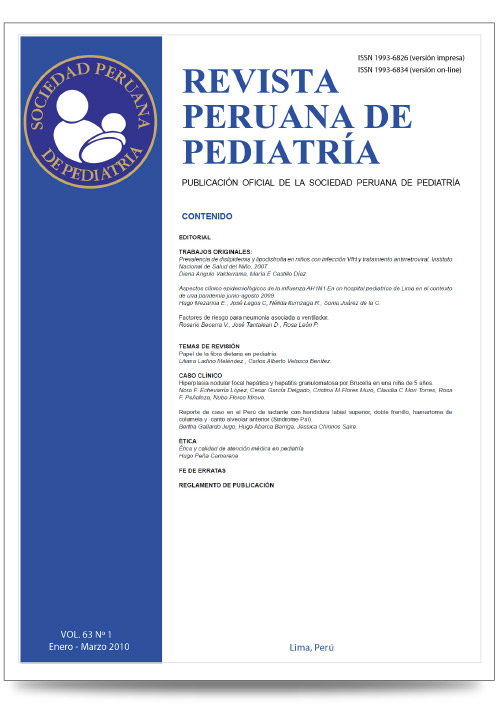Clinical epidemiologic aspects of influenza AH1N1 in a pediatric hospital of Lima in the context of pandemics June - August 2009
DOI:
https://doi.org/10.61651/rped.2010v63n1p11-14Keywords:
Influenza A Virus, H1N1 Subtype, Pandemics, Reverse Transcriptase Polymerase Chain ReactionAbstract
Objective: To determine the clinical and epidemiological characteristics of influenza in hospitalized patients AH1N1 Hospital’s Emergency Department Lima - Peru, in the context of pandemic influenza AH1N1.
Methods: This descriptive study evaluated the epidemiological surveillance records of 98 hospitalized patients, initially classified as suspected Influenza AH1N1, who underwent nasal and pharyngeal swabs were sent to INS for confirmatory test RT real time-PCR, identified 57 confirmed cases.
Results: 58.16% of suspected patients were confirmed. The most affected group was the male with 57.89%, the average age was 4.05 years, over 60% came from the districts of San Juan de Lurigancho, El Augustino, La Victoria, Lima Cercado, Los Olivos y Ate. The 70.18% had a history of previous contact. Cough (89.5%), fever (87.7%), rhinorrhea (86.0%) and pharyngeal congestion (77.2%) were the most frequently reported signs; being lymphadenopathy, skin rash, ear pain and photophobia the least reported. The average time of disease was 3.53 days, the criterion of seriousness that occurred more frequently during the illness was respiratory distress (77.19%).
Downloads
Downloads
Published
How to Cite
Issue
Section
Categories
License

This work is licensed under a Creative Commons Attribution 4.0 International License.
Authors will retain the copyright and grant the right to publish their work in the journal while allowing third parties to share it under the Creative Commons Attribution license.
Articles are published under a Creative Commons license that allows sharing and adaptation with appropriate credit. CC BY 4.0 license. Available in English at https://creativecommons.org/licenses/by/4.0/
Authors may use other information disclosure formats as long as the initial publication in the journal is cited. The dissemination of the work through the Internet is recommended to increase citations and promote academic exchanges.
The published content does not necessarily reflect the specific point of view of the journal, and the authors assume full responsibility for the content of their article.




